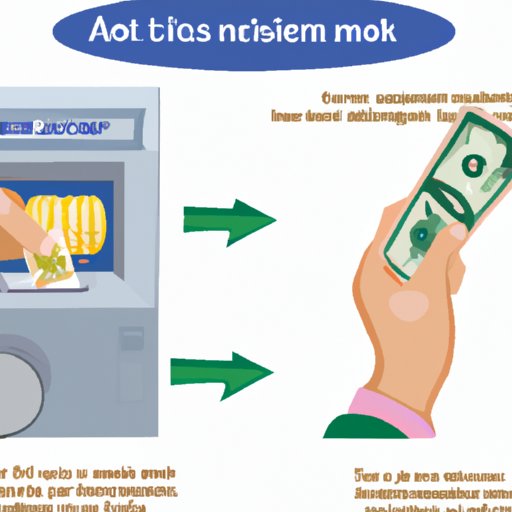
I. Introduction
Have you ever found yourself in need of depositing cash into your bank account but unsure of how to do it? Many people face this same problem and end up going to their bank during business hours or waiting in long lines just to interact with a teller. However, what if we told you that you could deposit cash at any time, all through an Automated Teller Machine (ATM)?
In this article, we will explain how you can deposit money into an ATM safely and securely. We will go over the mechanics of cash deposits, the benefits of using ATMs, how to prepare your cash for deposit, the pros and cons of ATM deposits, the security measures involved in using ATMs, and a step-by-step guide for a smooth transaction.
II. The Mechanics of Depositing Money into an ATM
ATMs are designed to accept various forms of deposits, including cash. When you insert your card into an ATM, you are prompted to follow the instructions on the screen to choose the type of transaction you want to make. To make a cash deposit, you will select the option that allows you to deposit money into your account.
There are two types of ATMs that can accept cash deposits. The first type, known as cash-in ATMs, is designed to accept cash deposits directly into the machine. The second type, known as cash recycling ATMs, has the ability to accept, sort, and store cash deposits, making it possible for future withdrawals.
III. Why Depositing Money into an ATM Can Be Convenient for You
Using ATMs can be much more convenient than going to a bank during business hours, waiting in line, or dealing with a teller. ATM cash deposits allow you to deposit money into your account at any time and from any location with ATM access. Additionally, the process can be much quicker than dealing with a teller.
IV. How to Properly Prepare Your Cash Deposit for an ATM
Before heading to the ATM, it is important to properly prepare your cash deposit to ensure a smooth transaction. Count your money before leaving home and organize it in an envelope or deposit slip. It is also essential to ensure that your bills are crisp and free from creases, tears, or any damage that may cause the machine to reject them.
When depositing different denominations of bills, make sure to separate them and follow the ATM’s instructions for the best arrangement. It is also helpful to keep your deposit slip and receipt for your records.

V. The Pros and Cons of Depositing Money into an ATM
While ATM cash deposits can be very convenient, they also have their share of benefits and risks. One of the significant advantages of using an ATM for cash deposits is that it can save you time and money, especially if it is free of charge. However, some banks may charge a fee for the transaction, which can add up over time. Additionally, ATM cash deposits may come with transaction limits that may be lower than those of a teller, so it may not be suitable for large deposits. Furthermore, errors may occur during the transaction process, potentially causing setbacks and longer processing times.
VI. Understanding the Security Measures for Depositing Money into an ATM
Despite the risks, your cash deposits in an ATM are typically safe, thanks to the numerous security measures involved. ATMs use encryption technology to keep your data and money secure. Deposits are stored in secure vaults and picked up regularly by armored vehicles for safe transport to the bank. However, it is essential to remain vigilant of potential scams, such as fake ATMs, skimming devices, and thieves lurking in the vicinity. Choose ATMs that are within a bank’s premises, well-lit, and secure.
VII. How ATM Technology Has Evolved to Accommodate Cash Deposits
ATM technology has come a long way since its introduction in the 1960s. In the past, ATMs could only withdraw cash and provide account information. Today, ATMs are designed to not only accept cash deposits but also assist with other banking transactions, such as check deposits, bill payments, and money transfers. Additionally, new technologies, such as image recognition and biometric authentication, are continuously being developed to make ATM transactions even more convenient and secure.
VIII. A Step-by-Step Guide to Depositing Money into an ATM Safely and Securely
Here is a detailed step-by-step guide to depositing cash into an ATM:
- Insert your ATM debit card.
- Enter your PIN number to access your account.
- Select the deposit option.
- Follow ATM instructions to choose the deposit account (checking or savings).
- Input the amount of cash you wish to deposit. Press “continue” and verify the amount.
- Insert your cash into the ATM cash slot. Your deposit may be accepted, rejected, or the machine may prompt you to insert the bills again.
- Wait for the ATM to process the deposit and offer a receipt.
- Collect your card, cash, and receipt. Keep your receipt for your records.
IX. Conclusion
Depositing cash into an ATM is a convenient and efficient way to add funds to your banking account. With proper preparation and vigilance, you can safely and securely navigate the process. Remember to always stay aware of potential scams and to opt for secure ATMs. Next time you find yourself needing to make a cash deposit, try using an ATM instead of going to the bank.




